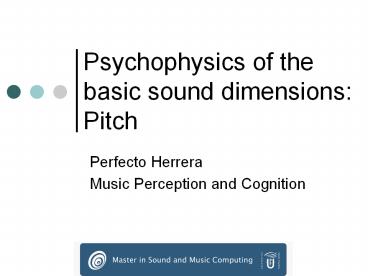Psychophysics of the basic sound dimensions: Pitch - PowerPoint PPT Presentation
1 / 23
Title:
Psychophysics of the basic sound dimensions: Pitch
Description:
ANSI (1973): 'that attribute of auditory sensation in terms of ... The brain processes the information present in the overtones to calculate the missing pitch. ... – PowerPoint PPT presentation
Number of Views:34
Avg rating:3.0/5.0
Title: Psychophysics of the basic sound dimensions: Pitch
1
Psychophysics of the basic sound dimensionsPitch
- Perfecto Herrera
- Music Perception and Cognition
2
Pitch
- ANSI (1973) "that attribute of auditory
sensation in terms of which sounds may be ordered
on a scale extending from low to high" - Plack (2005) The aspect of auditory sensation
whose variation is associated with musical
melodies
3
Frequency perception absolute thresholds
- 20Hz 20kHz (in young, intact hearing systems,
16kHz in adults) - HF threshold permanent decrease due to
- Ototoxic substances aspirin, quinine
- Exposition to high levels of sound pressure
(gt85dBSPL) for long periods of time
4
Components of the pitch sensation
- Shepards double helix model pitch heigth and
chroma - Tones are judged to be more similar when they
share chroma (just up to 5 kHz) - Both dimensions can be separately manipulated and
different brain regions are activated accordingly
5
Pitch sensation thresholds
- Region for pitch 30Hz-5000Hz
- Highest piccolo note 4500Hz
- First harmonic is not needed in order to generate
a pitch sensation corresponding to that frequency
(missing fundamental)
6
Pitch differential threshold
- HF tones The JND for pitch is around 0.5 of the
base frequency - But it is gt 1 for freq gt 5000Hz
- LF tones It is better than 3
7
Duration and pitch
- The dotted line is a reference indicating the
duration of 2 cycles -gt 10 cycles are a rough
minimum
8
Intensity effects on pitch
- High pitch tones tend to be perceived higher with
high pressure, lower with low pressure - Low pitch tones tend to be perceived lower with
high pressure, higher with low pressure
9
Subjective scale for pitch Mel
- How far in frequency do we have to be in order to
feel a tone as doubled in pitch? - m 1127 ln (1 f / 700)
- 8kHz2840mel / 500Hz607mel
- f 700 exp(m / 1127) - 1
- Mel-scaling is used in signal processing to build
filters that approximate our pitch perception
(MFCC)!!!
10
Pitch strength
- Pitch strength is mostly determined by the
microstructure of the waveform (the simpler, the
strongest pitch) - Secondarily, the amplitude envelope has also some
role (random-phase -gt weak pitch)
11
Absolute pitch
- The ability to name a sounded pitch or to produce
a pitch in response to a note name. Possessors of
AP name pitches rapidly and without effort or
conscious strategy - It is contrasted with relative pitch (RP), the
ability to identify notes relative to sounded
reference pitch(es) - Memory tasks find that pitch memory is
approximately equal for possessors and
nonpossessors of AP for delays up to one minute,
but only AP possessors perform above chance for
longer delays - Various findings implicate verbal codes
- AP can be learned most easily during a limited
period of development, possibly comparable to a
critical period for language learning - AP involves several neurally separate
subprocesses (pitch perception, classification,
labelling, storage in long-term memory, retrieval
from memory)
12
Pitch of pure tones
Place theories Place of maximum in basilar
membrane excitation (excitation pattern) -
which fibers are excited?
Timing theories Temporal pattern of firing -
how are the fibers firing? - needs phase locking
13
Place theory
Peaks in excitation
Pitch frequency of fundamentalCoded by place
of excitation
14
Problems for a place theory Missing fundamental
No fundamental but you still hear the pitch at
200 Hz Have you ever listened to male speakers on
an old radio receptor with tiny loudspeakers? Any
trouble?
15
The missing fundamental
- The pitch of a tone having partials at 300, 400,
500 and 600 Hz will be 100Hz - even though there is no energy present there!!!
- Remember when you listened to small radio tuners
with tiny loudspeakers included? The low-freq
male speakers sounded right even though its
impossibility to reproduce 100Hz tones - The brain processes the information present in
the overtones to calculate the missing pitch.
16
Problems for a place theory Masking the
fundamental
Unmasked complex still has a pitch of 200 Hz
17
Timing theory Phase-locking
18
Timing theory Phase-locking
19
Timing theory Unresolved harmonics in critical
bands
Maybe a different kind of pitch? (residual pitch)
Pitch due to beats of unresolved harmonics
inside a CB
20
Problems for a temporal theory
- Pitch sensation is strongest for low-order
(resolved) harmonics - Pitch can be elicited by only two components, one
in each ear - Pitch can be elicited by consecutively presented
harmonics
21
Pattern matching models
401 2 200.5 3 133.6 4 100.25 8 50.5 602 2
301 3 200.6 4 150.5 5 120.4 6 100.3 7 82 8
75.25 12 50.1 804 2 402 3 268 4 201 5
160.8 6 134 16 50.25
- Pitch based on resolved harmonics
- A harmonic template is used to determine the
pitch - Brain estimates frequencies of resolved harmonics
- could be by a place mechanism, but more likely
through phase-locked timing information. - Then finds the best-fitting consecutive harmonic
series to those numbers (eg 401 602 804) -gt pitch
of 100.5 - Divide the freq of partials by 2,3,4,5,6,7,8 and
select the highest common partial (200.5,
200.6, 201, not 50!)
22
Two pitch mechanisms ? (Duplex Theory)
- Pattern matching models have difficulty with the
fact that unresolved harmonics have a pitch at
all. - So Pattern matching models could be good as the
main pitch mechanism - With repetition pitch being a separate (weaker)
mechanism for unresolved harmonics
23
Two complementary mechanisms
Pattern matching mechanism
Timing-based mechanism
Pitch due to beats of unresolved harmonics































